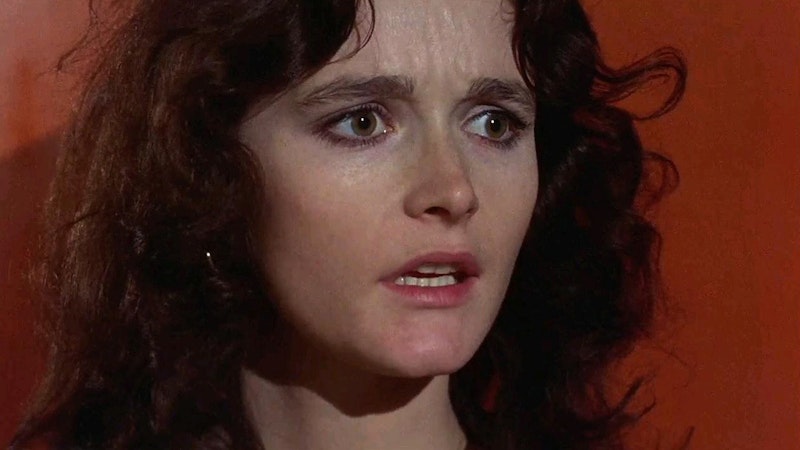Unsettling, uneasy, macabre—these are some of the words that describe Brian De Palma’s cinematic oeuvre. This is especially true of de Palma’s early films, which are often odd combinations of horror, comedy, and social commentary. Sisters (1973) is no exception.
Inspired by the real-life story of Russian conjoined twins, De Palma constructed a story in Sisters as a tale of psychological disturbance. Reading about Masha and Dasha Krivoshlyapov in Life magazine, De Palma was intrigued by one caption accompanied by a bizarre picture of the Russian twins, which stated that one twin was happy and content, while the other was in a state of mental disturbance, if not insanity. This intrigued De Palma: what would happen if they suddenly became separated?
It wasn’t only the idea of twins’ separation that made an impact on De Palma’s creativity. It was also a notion of voyeurism and how it relates to the psychological disturbances present in the twins. Looking out or in, paths taken in order to look, and subsequent results of looking are part of De Palma’s cinematic vocabulary. Here, too, (partly inspired by Hitchcock), De Palma goes under the skin and into the mind of both the perpetrator and victim.
Margot Kidder plays Danielle Breton, a French-Canadian actress and model. After finishing her appearance on a television show (appropriately called The Peeping Tom), she and co-star, Phillip Woode (Lisle Wilson) go out to dinner, which ends with sex at Danielle’s apartment. This appears as not just another one-night-stand, but a possibility of a warm and tender relationship.
Phillip is unaware of Danielle’s (or is it her twin sister Dominique?) dark side, and ends up murdered by Danielle/Dominique. On the other side of the apartment building is Grace Collier (Jennifer Salt), a frustrated journalist who’s tired of writing about dumb events happening in Staten Island, and yearns for that big story that exposes corruption and crime. She witnesses Phillip fighting for his life as his bloody hands try to write out “HELP” on the window.
Grace immediately calls the police but the detective and his assistant aren’t particularly interested in checking out Danielle’s apartment. The detective’s view is that Grace is making this up for the purposes of a good newspaper story. In addition, De Palma creates a sense of soft misogyny on the part of the detective: who wants to believe a hysterical woman?
As detectives and Grace make their way to Danielle’s apartment, De Palma uses a split screen to let the viewer know exactly what’s happening with Danielle. At this point, a man called Emil claiming to be Danielle’s ex-husband has entered the picture, and is diligently helping Danielle clean the apartment from the traces of blood, as well as craftily hiding Phillip’s dead body in the pull-out couch. During this time (and for most of the film), Kidder’s Danielle is frustratingly passive. This passivity caused the viewer to be annoyed. Even her attempt at being seductive with the detective, when he makes his necessary inquiries, is irritating because what’s hiding behind that image is a manipulative waif. She practically needs help walking and breathing at the same time, and this helplessness renders Danielle repulsive, especially to Grace. Yet men like Phillip and the detective are attracted to it.
A great contrast to Danielle is Grace. Salt’s Grace is powerful, almost masculine in her delivery, yet she spends most of the time trying to prove to men that she’s capable of independence and intelligence. This inevitable outpouring of emotion makes Grace look like another hysterical feminist, despite the fact that she’s mostly driven to seek justice for Phillip’s murder.
But how much of that is true? Is Grace interested in justice (at some point, she tries to sell a story to a magazine by emphasizing the fact that Phillip is a black man) or just trying to further her career? What makes her different then from Danielle? Isn’t Grace too manipulative in her own simplistically feminist way.
Sisters oscillates between a straightforward murder story and a series of surrealist impressions brought on by the various disturbances of the mind. It is at once a campy slasher film, a social commentary of women’s roles in society, and a strange nightmare populated by freaks. In De Palma’s case, there were many circus freaks that were brought onto the set, who served as insane asylum inhabitants. Shot in black and white, these delirious scenes are meant to evoke photographs of Soviet Union’s doctors who treated (read: experimented on) the Russian conjoined twins. Grace is thrown into this world, and for a short amount of time, she becomes the test subject within a time and place that doesn’t exist. Her identity becomes enmeshed with Danielle/Dominique and the question of womanhood itself is brought onto the surface.
Yet, it would be too simple to say that De Palma made a film that’s first and foremost commenting on the Women's Liberation movement or Second Wave of Feminism. Even throughout other films, one is never quite sure how De Palma views women. Is he a voyeur? Is he a misogynist? Is he exposing misogyny? Much like John Cassavetes, he’s fascinated by women, but the intentions and desires are of darker nature, lurking in the shadows, moving quickly from grimy reality to erotic surrealism. One of De Palma’s great gifts is combining the erotic with the horrific. It’s here that we see voyeurism fully realized and enfleshed.
The tragedy in Sisters is not Danielle/Dominique’s fate or Grace’s hypnotic submission to the experimentation and suppression. As much as these lurid and nightmare-inducing events are horrific, it’s Phillip Woode who is the victim of tragic circumstances. It’s his dead body that ends up inside the couch, transported by the moving company to the non-descript woods of Canada. He’s a nobody: unclaimed and unknown, as if he never existed.

